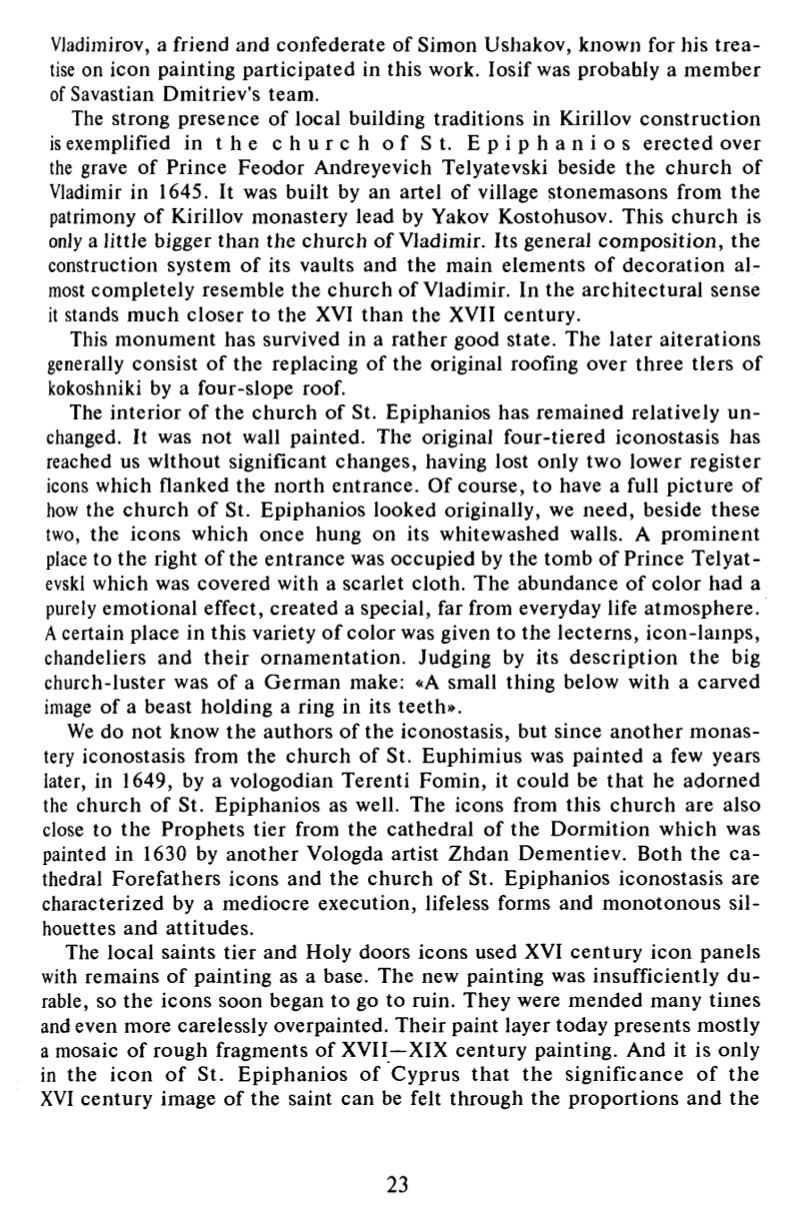

Vladimirov, a friend and confederate of Simon Ushakov, known for his tre a
tise on icon painting participated in this work. Iosif was probahly a member
of Savastian Dmitriev's team.
The strong presence of local building traditions in Kirillov construc tion
is exemplified in t h e c h u r c h o f St . E p i p h a n i o s erected over
the grave of Prince Feodor Andreyevich Telyatevski beside the chu rch of
Vladimir in 1645. It was built by an artel of village stonemasons from the
patrimony o f Kirillov monastery lead by Yakov Kostohusov. This chu rch is
only a little bigger than the church o f Vladimir. Its general composition , the
construction system o f its vaults and the main elements o f deco ra tion a l
most completely resemble the church o f Vladimir. In the arch itectural sense
it stands much closer to the XVI than the XVII century.
This monumen t has survived in a rather good state. The later alterations
generally consist o f the replacing o f the original roofing over three tiers of
kokoshniki by a four-slope roof.
The interior o f the church of St. Epiphanios has remained relatively u n
changed. It was not wall painted. The original four-tiered iconostasis has
reached us without significant changes, having lost only two lower register
icons which flanked the north entrance. Of course, to have a full p icture of
how the chu rch o f St. Epiphanios looked originally, we need, beside these
two, the icons which once hung on its whitewashed walls. A prominen t
place to the right o f the entrance was occupied by the tomb o f Prince Telyat
evski which was covered with a scarlet cloth. The abundance o f color had a
purely emotional effect, created a special, far from everyday life atmosphere.
A certain place in this variety o f color was given to the lecterns, icon-lainps,
chandeliers and their o rnamen tation . Judging by its descrip tion the big
church-luster was o f a German make: «А small thing below with a carved
image of a beast holding a ring in its teeth».
We do not know the authors o f the iconostasis, but since ano the r monas
tery iconostasis from the church o f St. Euphimius was pain ted a few years
later, in 1649, by a vologodian Terenti Fomin, it could be that he adorned
the church o f St. Epiphanios as well. The icons from this chu rch are also
close to the Prophets tier from the cathedral of the Dormition which was
painted in 1630 by ano ther Vologda artist Zhdan Dementiev. Both the c a
thedral Forefathers icons and the chu rch of St. Epiphanios iconostasis are
characterized by a mediocre execution, lifeless forms and mono tonous sil
houettes and attitudes.
The local saints tier and Holy doors icons used XVI century icon panels
with remains o f painting as a base. The new painting was insufficiently d u
rable, so the icons soon began to go to ruin. They were mended many times
and even more carelessly overpainted. Their paint layer today presents mostly
a mosaic of rough fragments o f XVII—XIX century painting. And it is only
in the icon o f St. Ep iphan ios o f Cyprus tha t the sign ificance o f the
XVI century image o f the saint can be felt through the proportions and the
23















